Nazi concentration camp badge
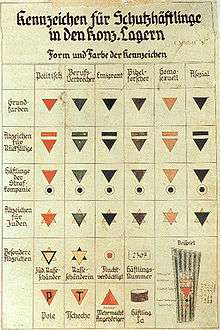
Nazi concentration camp badges, primarily triangles, were part of the system of identification in Nazi camps. They were used in the concentration camps in the Nazi-occupied countries to identify the reason the prisoners had been placed there.[1] The triangles were made of fabric and were sewn on jackets and trousers of the prisoners. These mandatory badges of shame had specific meanings indicated by their colour and shape. Such emblems helped guards assign tasks to the detainees: for example, a guard at a glance could see if someone were a convicted criminal (green patch) and thus likely of a "tough" temperament suitable for kapo duty. Someone with an "escape suspect" mark usually would not be assigned to work squads operating outside the camp fence. Someone wearing an F could be called upon to help translate guards' spoken instructions to a trainload of new arrivals from France. Some historical monuments quote the badge-imagery; the use of a triangle being a sort of visual shorthand to symbolize all camp victims. The modern day use of a pink triangle emblem to symbolize gay rights is a response to the camp identification patches.
Badge coding system
The system of badges varied between the camps, and in the later stages of World War II, the use of badges dwindled in some camps, and became increasingly accidental in others. The following description is based on the badge coding system used before and during the early stages of the war in the Dachau concentration camp, which had one of the more elaborate coding systems.
Shape was chosen by analogy with the common triangular road hazard signs in Germany that denote warnings to motorists. Here, a triangle is called inverted because its base is up while one of its angles points down.
Single triangles
- Red triangle—political prisoners: social democrats, socialists, trade unionists, Freemasons, communists, and anarchists.
- Green triangle— "professional criminals" (convicts, often working in the camps as kapos).
- Blue triangle—foreign forced laborers, emigrants.
- Purple triangle—primarily Jehovah's Witnesses (over 99%), and members of other small religious groups.[2]
- Pink triangle—primarily homosexual men, as well as sexual offenders including rapists, paedophiles and zoophiles.[3]
- Black triangle—people who were deemed "asocial elements" (asozial) and "work shy" (arbeitsscheu) including
- Roma. They wore the black triangle with a "Z" notation (for Zigeuner, meaning Gypsy) to the right of the triangle's point.[4] Roma males were later assigned a brown triangle. Roma females were still deemed "asocials" as they were stereotyped as petty criminals (prostitutes, kidnappers, and fortune tellers).
- The mentally ill and mentally disabled. Their triangles were inscribed with the word Blöd ("stupid").[5]
- Alcoholics and drug addicts
- Vagrants and beggars
- Pacifists and conscription resisters.
- Prostitutes[6][7]
- Some anarchists
- Lesbian women[8]
- Brown triangle—Roma males.
- Uninverted red triangle — an enemy POW (Sonderhäftling — "Special Detainee"), a spy or traitor (Aktionshäftling — "Activities Detainee"), or a military deserter or criminal (Wehrmachtsangehöriger — "Service Member").
People who wore the green and pink triangles were convicted in criminal courts and may have been transferred to the criminal prison systems after the camps were liberated.
- Some period examples of the single triangle design at Nazi camps
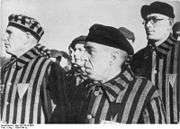 Single-triangle badges in various colors visible on Sachsenhausen concentration camp detainees.
Single-triangle badges in various colors visible on Sachsenhausen concentration camp detainees. Single-triangles visible on Sachsenhausen detainees.
Single-triangles visible on Sachsenhausen detainees.- Specimen indicating a Jehovah's Witness.

 More Sachsenhausen detainees.
More Sachsenhausen detainees.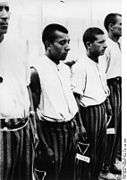
 U.S. Army photo of Buchenwald survivor Benedikt Kautsky.
U.S. Army photo of Buchenwald survivor Benedikt Kautsky. Liberated Neuengamme survivor standing on the right has a triangle patch with a top-bar.
Liberated Neuengamme survivor standing on the right has a triangle patch with a top-bar.
Double triangles
Double-triangle badges resembled two superimposed triangles forming a Star of David, a Jewish symbol.
- Two superimposed yellow triangles or a six-pointed star, the "Yellow badge"— a Jew. The word Jude ("Jew") was often inscribed in faux-Hebrew-looking letters inside the center of the badge.
- Red inverted triangle superimposed upon a yellow one—a Jewish political prisoner
- Green inverted triangle upon a yellow one—a Jewish "habitual criminal"
- Purple inverted triangle superimposed upon a yellow one—a Jehovah's Witness of Jewish descent[9]
- Pink inverted triangle superimposed upon a yellow one—a Jewish "sexual offender"
- Black inverted triangle superimposed upon a yellow one—"asocial" and "work shy" Jews
- Voided black inverted triangle superimposed over a yellow triangle—a Jew convicted of miscegenation and labelled as a Rassenschänder ("race defiler").
- Yellow inverted triangle superimposed over a black triangle—an Aryan (woman) convicted of miscegenation and labelled as a Rassenschänder ("race defiler").
Like those who wore pink and green triangles, people in the bottom two categories would have been convicted in criminal courts.
- Some period examples of the double triangle design at Nazi camps
 Sachsenhausen detainee with glasses in the foreground wears a two-color ID-emblem.
Sachsenhausen detainee with glasses in the foreground wears a two-color ID-emblem.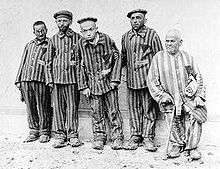 Disabled Jews with a black triangle on a yellow triangle, meaning "asocial Jews". Buchenwald, 1938.
Disabled Jews with a black triangle on a yellow triangle, meaning "asocial Jews". Buchenwald, 1938.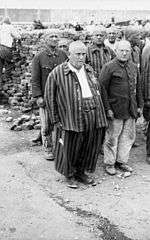 Part of a Dachau roll call—badges visible on detainees.
Part of a Dachau roll call—badges visible on detainees.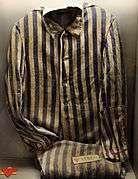
Distinguishing marks
In addition to colour-coding, some groups had to put letter insignia on their triangles to denote country of origin. Red triangle with a letter, for example: "B" (Belgier, Belgians), "E" (Engländer, English), "F" (Franzosen, French), "H" (Holländer, Dutch), "I" (Italiener, Italians), "J"[10] (Jugoslawen, Yugoslavs), "N" (Norweger, Norwegian), "P" (Polen, Poles), "S" (republikanische Spanier, Republican Spanish) "T" (Tscheche, Czechs), or "U" (Ungarn, Hungarians). A "Z" notation next to a Black Triangle (Zigeuner, Gypsy).
Also, repeat offenders (rückfällige > "recidivists") would receive bars over their stars or triangles, a different colour for a different crime.
- A political prisoner would have a red bar over his/her star or triangle
- A professional criminal would have a green bar
- A foreign forced laborer would have a blue bar
- A Jehovah's Witness would have a purple bar
- A homosexual or sex offender would have a pink bar
- An "asocial" would have a black bar
- Roma (Gypsies) would usually be incarcerated in special sub-camps until they died and so would not normally receive a repeat stripe.
Later in the war (late 1944), to save cloth, Jewish prisoners wore a yellow bar over a regular point-down triangle to indicate their status. For instance, regular Jews would wear a yellow bar over a red triangle while Jewish criminals would wear a yellow bar over a green triangle.
Special marks
Many various markings and combinations existed. A prisoner would usually have at least two, and possibly more than six.
"Limited Preventative Custody" detainee ("Befristete Vorbeugungshaft" Häftling, or BV) was the term for general criminals (who wore green triangles with no special marks). They originally were only supposed to be incarcerated at the camp until their term expired and then they would be released. However, when the war began they were confined indefinitely for its duration.
Erziehungshäftlinge ("Reformatory Inmates") wore E or EH in large black letters on a white square. They were made up of intellectuals and respected community members who could organize and lead a resistance movement, suspicious persons picked up in sweeps or stopped at checkpoints, people caught performing conspiratorial activities or acts, and inmates who broke work discipline. They were assigned to hard labor for 6 to 8 weeks and were then released. It was hoped that the threat of permanent incarceration at hard labor would deter them from further mischief.
Polizeihäftlinge ("Police Inmates"), short for Polizeilich Sicherungsverwahrte Häftlinge ("Police Secure Custody Inmates"), wore either PH in large black letters on a white square or the letter S (for Sicherungsverwahrt - "Secure Custody") on a green triangle. To save expense, some camps had them just wear their civilian clothes without markings. Records used the letter PSV (Polizeilich Sicherungsverwahrt) to designate them. They were people awaiting trial by a police court-martial or who were already convicted. They were detained in a special jail barracks until they were executed.
Some camps assigned Nacht und Nebel prisoners had them wear two large letters, NN (for Nacht und Nebel - "Night and Fog") in yellow.
Soviet prisoners of war (russische Kriegsgefangenen) assigned to work camps (Arbeitslager) wore two large letters, SU (for sowjetischer Untermensch - "Soviet Sub-Human") in yellow and had vertical stripes painted on their uniforms. Those who were not shot out of hand before they could reach a camp or had died of neglect from untreated wounds, exposure to the elements, or starvation performed hard labor. Some joined Vlasov's Liberation Army to fight for the Germans.
"Labor Education Detainees" (Arbeitserziehung Häftling) wore a white letter A on their black triangle. This stood for Arbeitsscheuer ("Work-Shy Person") - designating "lazy" social undesirables like Gypsies, petty criminals (e.g., prostitutes and pickpockets), alcoholics / drug addicts, and vagrants. They were usually assigned to work at labor camps.
Asoziale ("Anti-Socials") inmates wore a plain black triangle. They were considered either too "selfish" or "deviant" to contribute to society or were considered too impaired to support themselves. They were therefore considered a burden. This category included pacifists and conscription resisters, petty or habitual criminals, the mentally ill, and the mentally and / or physically disabled. They were usually executed or euthanized.
The Wehrmacht Strafbattalion ("Punishment Battalion") and SS Bewährungstruppe ("Probation Company") were military punishment units. They consisted of Wehrmacht and SS military criminals, SS personnel convicted by an Honor Court of bad conduct, and civilian criminals for which military service was either the assigned punishment or a voluntary replacement of imprisonment. They wore regular uniforms but were forbidden rank or unit insignia until they had proven themselves in combat. They wore an uninverted (point-upwards) red triangle on their upper sleeves to indicate their status. Most were used for hard labor, "special tasks" (unwanted dangerous jobs like defusing landmines or running phone cables) or were used as forlorn hopes or cannon fodder. The infamous Dirlewanger Brigade was an example of a regular unit created from such personnel.
A Strafkompanie ("Punishment Company") (SK) was a hard labor unit in the camps. Inmates assigned to it wore a black roundel bordered white under their triangle patch.
Prisoners "suspected of [attempting to] escape" (Fluchtverdächtiger) wore a red roundel bordered white under their triangle patch. If also assigned to hard labor, they wore the red roundel under their black Strafkompanie roundel.
A Prisoner-Functionary (Funktionshäftling), or Kapo ("boss"), wore a cloth brassard (their Kennzeichen, or "identifying mark") to indicate their status. They served as camp guards (Lagerpolizei), barracks clerks (Blockschreiber), and the senior prisoners at the camp (lagerältester), barracks (blockältester) and room (stübenältester) levels of camp organization. They received privileges like bigger (and sometimes better) food rations, better quarters (or even a private room), luxuries (like tobacco or alcohol), and access to the camp's facilities (like the showers or the pool). Failure to please their captors meant demotion and loss of privileges - and an almost certain death at the hands of their fellow inmates.
Detainees wearing civilian clothing (more common later in the war) instead of the striped uniforms were often marked with a prominent X on the back.[11] This made for an ersatz prisoner uniform. For permanence, such Xs were made with white oil paint, with sewn-on cloth strips, or were cut (with underlying jacket-liner fabric providing the contrasting color). Detainees would be compelled to sew their number and (if applicable) a triangle emblem onto the fronts of such X-ed clothing.[11]
- Some period examples of nationality-letter marking at Nazi camps
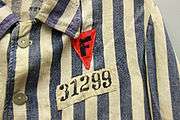
 Specimen meaning Polish political enemy.
Specimen meaning Polish political enemy.- Stutthof detainee 29659 – Lidia Główczewska: P on a red triangle for Polish political enemy.
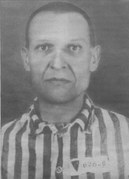 Auschwitz detainee Ignacy Kwarta wears a red P-triangle: a Polish political enemy.
Auschwitz detainee Ignacy Kwarta wears a red P-triangle: a Polish political enemy.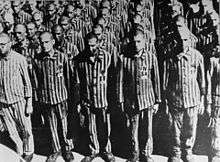 Dutch Jews wearing a yellow star and the letter N for Niederländer at Buchenwald.
Dutch Jews wearing a yellow star and the letter N for Niederländer at Buchenwald. Emblems were also used on some detainee ID-cards—here, on the Mauthausen card of Polish scientist Jerzy Kaźmirkiewicz, a P-triangle appears. ^
Emblems were also used on some detainee ID-cards—here, on the Mauthausen card of Polish scientist Jerzy Kaźmirkiewicz, a P-triangle appears. ^ Dachau survivors toast their liberation. The man standing in center between the bottles wears a P triangle.
Dachau survivors toast their liberation. The man standing in center between the bottles wears a P triangle.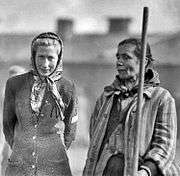 Liberated Bergen-Belsen survivor with (left) a late war ersatz variant: no cloth patch, but a prominent N marked on the outer clothes.
Liberated Bergen-Belsen survivor with (left) a late war ersatz variant: no cloth patch, but a prominent N marked on the outer clothes.
Table of camp inmate markings
| Politisch Political prisoner |
Berufsverbrecher Professional criminal |
Emigrant Foreign forced laborer |
Bibelforscher Bible Student (Jehovah's Witness) |
Homosexuell Male homosexual / sex offender |
Arbeitsscheu / Asozial Work-Shy / Asocial |
Zigeuner Gypsy (Roma or Sinti male) | |
|---|---|---|---|---|---|---|---|
| Basic colours | |||||||
| Markings for repeaters |  |
 |
 |
 |
 |
 |
 |
| Inmates of Strafkompanie (punishment companies) |  |
 |
 |
 |
 |
 |
 |
| Markings for Jews |  |
 |
 |
 |
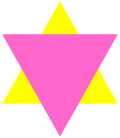 |
 |
 |
| Political prisoner nationality markings The capital letter of the name of the country on a red triangle |
Belgian (Belgier) | Czech (Tscheche) | French (Franzose) | Polish (Pole) | Spanish (Spanier) | ||
.png) |
|||||||
| Special markings | Jüdischer Rassenschänder Jewish race defiler |
Rassenschänderin Female race defiler |
Escape suspect | Häftlingsnummer Inmate number |
Kennzeichen für Funktionshäftlinge Special inmates' brown armband |
Enemy POW or deserter | |
 |
 |
 |
 |
||||
| Applicable of marks |  |
Applicable marks were worn in descending order as follows: inmate number, repeater bar, triangle or star, member of penal battalion, escape suspect. In this case, the inmate is a Jewish convict with multiple convictions, serving in a Strafkompanie (penal unit) and who is suspected of trying to escape. | |||||
Postwar use
Triangle-motifs appear on many postwar memorials to the victims of the Nazis. Most triangles are plain while some others bear nationality-letters. The otherwise potentially puzzling designs are a direct reference to the identification patches used in the camps. On such monuments, typically an inverted (point down, base up) triangle (especially if red) evokes all victims, including also the non-Jewish victims like Slavs, Poles, communists, homosexuals, Roma (see Porajmos), the handicapped (see Action T4), and Soviet POWs. An inverted triangle colored pink would symbolize gay male victims. A non-inverted (base down, point up) triangle and/or a yellow triangle is generally more evocative of the Jewish victims.
- Some examples of camp triangle emblems on monuments and related uses
- At Sachsenhausen.
- A Dora Todesmarsch (death march) roadside tablet marked only with the date and a red triangle.
 On the Klooga Jewish victims' memorial.
On the Klooga Jewish victims' memorial.- On a Buchenwald Todesmarsch (death march) route historical marker.
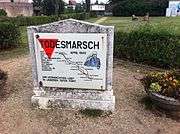 On a Sachsenhausen death march route historical marker.
On a Sachsenhausen death march route historical marker. Monument (in the village of Grabow-Below) for Ravensbrück death march victims.
Monument (in the village of Grabow-Below) for Ravensbrück death march victims.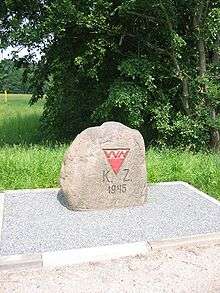 On a Wöbbelin memorial stone.
On a Wöbbelin memorial stone..jpg) Boulder (in Lindenring) "for 2000 women" victims of Ravensbrück.
Boulder (in Lindenring) "for 2000 women" victims of Ravensbrück.- On a Cap Arcona incident memorial.
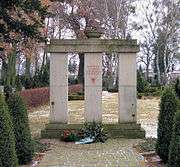 At the Neustadt-Glewe concentration camp memorial.
At the Neustadt-Glewe concentration camp memorial.- F-triangle at Mauthausen-Gusen honors French victims.
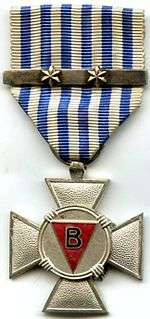 B-triangle incorporated into the Belgian Political Prisoner's Cross
B-triangle incorporated into the Belgian Political Prisoner's Cross F-triangle at Hinzert honors French victims—especially of the Nacht und Nebel (Night and Fog) program.
F-triangle at Hinzert honors French victims—especially of the Nacht und Nebel (Night and Fog) program._1973%2C_MiNr_1878.jpg) On a Langenstein-Zwieberge memorial (pictured on an East German stamp).
On a Langenstein-Zwieberge memorial (pictured on an East German stamp).- On a monument to Neuengamme victims in Hamburg. The letters KZ are not nationality-letters but rather are the German abbreviation for Konzentrationslager (concentration camp).
- On a memorial to victims killed at Genshagen (right panel). The letters KZ are not nationality-letters but rather are the German abbreviation for Konzentrationslager (concentration camp).
- P-triangle at a Zgorzelec memorial.
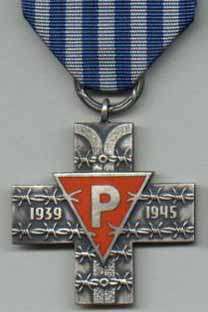 P-triangle on the Polish medal for camp victims.
P-triangle on the Polish medal for camp victims.
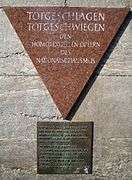 In the Berlin Nollendorfplatz subway station, a pink triangle plaque honors gay male victims. (Photo by: Manfred Brueckels.)
In the Berlin Nollendorfplatz subway station, a pink triangle plaque honors gay male victims. (Photo by: Manfred Brueckels.) Amsterdam's Homomonument uses pink triangles symbolically to memorialize gay men killed in the Holocaust (and also victims of anti-gay violence generally).
Amsterdam's Homomonument uses pink triangles symbolically to memorialize gay men killed in the Holocaust (and also victims of anti-gay violence generally).
Notes
- ↑ Nazis Open Dachau Concentration Camp
- ↑ Johannes S. Wrobel, Jehovah’s Witnesses in National Socialist Concentration Camps, 1933 – 45, Religion, State & Society, Vol. 34, No. 2, June 2006, pp. 89-125 "The concentration camp prisoner category ‘Bible Student’ at times apparently included a few members from small Bible Student splinter groups, as well as adherents of other religious groups which played only a secondary role during the time of the National Socialist regime, such as Adventists, Baptists and the New Apostolic community (Garbe 1999, pp. 82, 406; Zeiger, 2001, p. 72). Since their numbers in the camps were quite small compared with the total number of Jehovah’s Witness prisoners, I shall not consider them separately in this article. Historian Antje Zeiger (2001, p. 88) writes about Sachsenhausen camp: ‘In May 1938, every tenth prisoner was a Jehovah’s Witness. Less than one percent of the Witnesses included other religious nonconformists (Adventists, Baptists, pacifists), who were placed in the same prisoner classification.’"
- ↑ Plant, The Pink Triangle.
- ↑ Jewish Virtual Museum: Badges
- ↑ The Holocaust Revealed – Badges
- ↑ Claudia Schoppmann: Nationalsozialistische Sexualpolitik und weibliche Homosexualität (Dissertation, FU Berlin, 1990.) Centaurus, Pfaffenweiler 1991 (revisited 2nd edition 1997). ISBN 3-89085-538-5
- ↑ "Black triangle women". 1 February 2001. Archived from the original on 2009-02-12. Retrieved 2 February 2008.
- ↑ "Eastern Illinois University :: LGBTQA WebCenter - Symbolism". castle.eiu.edu. Retrieved 2016-06-04.
- ↑ Note that since "Jew" was defined along "racial" lines, such as by the Nuremberg Laws, Jews could be classified as Jehovah's Witnesses.
- ↑ Politika: У Аушвицу, на вест о ослобођењу Београда
- 1 2 Rochelle G. Saidel (2006). The Jewish Women of Ravensbrück Concentration Camp (pg 76). Retrieved 20 May 2013.
References
- Plant, Richard, The Pink Triangle: The Nazi War Against Homosexuals, Owl Books, 1988, ISBN 0-8050-0600-1.
- Camp badge chart at historyplace.com
- Additional camp badge chart
External links
-
 Media related to Nazi concentration camp badges at Wikimedia Commons
Media related to Nazi concentration camp badges at Wikimedia Commons - United States Holocaust Memorial Museum Classification system in Nazi concentration camps.
- Stars, triangles and markings – Jewish Virtual Library
- Gay Prisoners in Concentration Camps as Compared with Jehovah's Witnesses and Political Prisoners by Ruediger Lautmann